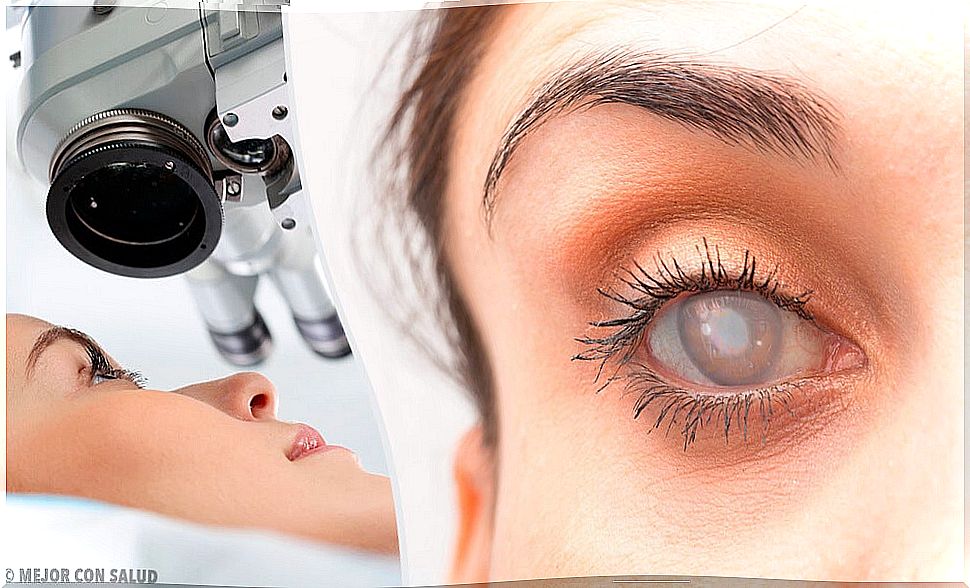What Is Iritis And Why Does It Occur?
The symptoms that people with iritis present are very general, so the diagnosis of the disease is often difficult. However, it is a condition that has serious consequences.

The eyeball is a specialized structure for capturing and transmitting light stimuli. The iris is in charge of regulating the amount of light that the retina absorbs. For what a condition is this structure can be quite annoying. Are you interested in knowing what iritis is and why it occurs?
The iris is the pigmented ring located between the cornea and the lens. It constitutes the uvea or vascular tunica media of the eye together with the ciliary body and the choroid. In addition, it presents a series of muscles that contract and relax, adjusting the size of the central opening or pupil.
Inflammation or swelling of the iris is known as anterior iritis or uveitis. It usually develops quickly and affects only one eye. However, in some people it manifests itself in both. Early treatment is crucial, as it helps avoid complications such as glaucoma and vision loss.
Symptoms of iritis
In most cases, iritis is quite annoying for the patient, since it is capable of affecting visual capacity and hindering daily activities.
The main clinical manifestations associated with inflammation of the iris are the following:
- Eye pain and tenderness.
- Foreign body sensation in the eye.
- Red eyes
- Increase in tear production.
- Sensitivity to bright and intense lights.
- Cloudy or blurred vision.
- Headache.
This condition usually manifests itself acutely and suddenly, subsiding in a period of less than 6 weeks. However, in some patients it may have a chronic presentation and last for more than 3 months.

Causes and risk factors
Anterior uveitis is common in young adults between the ages of 20 and 50. However, it can also occur in children and adolescents. The origin of this condition is very varied, which makes the initial diagnosis difficult.
It is estimated that iritis can be triggered by external factors, such as trauma and infections, as well as by endogenous alterations, typical of the eyeball or as a result of systemic conditions. Common sources are high intensity blunt trauma and short penetrating injuries.
On the other hand, among the causes of iritis due to non-traumatic conditions, the following stand out:
- Herpes Zoster virus infection.
- Toxoplasmosis
- Tuberculosis.
- Syphilis.
- HIV AIDS.
- Reactive or psoriatic arthritis.
- Inflammatory bowel disease
- Sarcoidosis
- Reiter’s syndrome.
- Lyme’s desease.
- Medicines, such as rifabutin and cidofovir.
Recently, a relationship was found between the Ebola hemorrhagic virus with conditions such as uveitis and panuveitis, manifesting itself in more than 15% of patients.
Similarly, there are several factors that can increase the risk of suffering from iritis and the possibility of suffering complications, among which are the following:
- Consumption of tobacco and cigarettes.
- Hereditary alteration of the HLA-B27 gene, responsible for the stability of the immune system.
- Sexually transmitted diseases.
- Autoimmune pathologies .
Complications of iritis
The negative prognosis associated with retinal inflammation is related to the delay in diagnosis and its late or inappropriate treatment.
Among the main complications of iritis are the following:
- Cataracts: it is an opacity of the lens that affects its refractory capacity, which is why the person tends to manifest progressive loss of vision. This represents the most common complication of uveitis, present in more than 30% of cases.
- Macular edema : thickening of the retinal macula that can present with or without cystic lesions. It usually generates from cloudy vision to loss of vision. It is responsible for more than 20% of complications.
- Retinal alterations : they are associated with retinal detachment or tear, formation of pathological vessels and vascular occlusions, which have been identified in 15% of cases with a negative course.
- Maculopathies: related to macular necrosis, as well as choroidal neovascular membrane (CNVM) and epiretinal membrane (ERM). They represent more than 14% of uveitis complications.
- Other complications: calcium deposits and irregular pupils.

Diagnosis
The diagnosis of iritis is made by a comprehensive exploration of the eyeball by the specialist in ophthalmology. The ocular symptoms identified during the interrogation are vital, allowing the development of clinical suspicion.
It is usually confirmed by the following tests:
- External ocular evaluation: the doctor will evaluate the different structures of the eye in a comparative way, with the aim of identifying and ruling out any condition. Similarly, pupillary reactivity will be studied with a small lamp, as well as the pattern of vascularization, secretion and redness of the globe.
- Visual acuity and visual fields test: with the help of tables or primers with figures and letters, the specialist will evaluate the focusing ability of the eyeball and its adaptive response. In the same way, by means of campimetry the integrity or affection of the visual quadrants will be identified.
- Fundus examination: an ophthalmoscope will be used to observe the internal structures of the eye, using magnifying lenses. The doctor will evaluate the retina, macula, optic disc, and retinal vessels for abnormalities.
Treatment for iritis
The therapeutic protocol is focused on the relief of ocular symptoms and on the control of the disease that is causing the inflammatory process. Similarly, it seeks to avoid the appearance of complications and the unfavorable evolution associated with vision loss.
It generally includes the following medications:
- Mydriatic eye solutions: drops that allow the pupil to dilate, reducing pain and sensitivity.
- Corticosteroids: drops used to reduce swelling and inflammation of the iris, in addition to reducing intraocular pressure. They relieve redness, pain, and the sensation of grit or a foreign body.
- Oral analgesics and anti-inflammatory drugs : drugs such as paracetamol and ibuprofen can be used to reduce pain and inflammation.
If the pain continues after several weeks of treatment, the specialist may resort to the use of oral corticosteroids or infiltrates around the eyeball. Regarding the sensitivity to light, it is advisable to use sunglasses or photochromic glasses.
Do not hesitate to seek ophthalmological help
Before the manifestation of iritis symptoms that affect the eyeball and make vision difficult, it is necessary to seek medical help immediately. The eye is a delicate structure that requires care and timely attention to avoid complications that reduce or cause total loss of vision.









